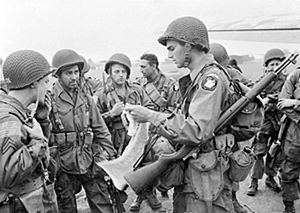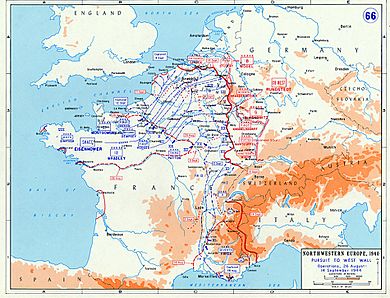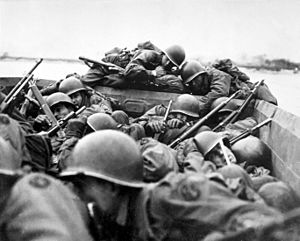Siegfried Line campaign facts for kids
Quick facts for kids Siegfried Line campaign |
|||||||
|---|---|---|---|---|---|---|---|
| Part of the Western Front of World War II | |||||||
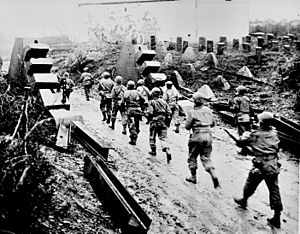 U.S. Army troops cross the Siegfried Line. |
|||||||
|
|||||||
| Belligerents | |||||||
| Commanders and leaders | |||||||
|
|
||||||
| Strength | |||||||
| 4,500,000 (91 divisions) | 1,500,000 | ||||||
| Casualties and losses | |||||||
|
|
||||||
The Siegfried Line campaign was an important part of World War II on the Western Front. It involved battles near the strong German defense line called the Siegfried Line.
This campaign started after the Battle of Normandy and the Allied chase across northern France. It lasted from August 1944 until March 1945. The campaign ended just before the Germans launched their big counter-attack, known as the Battle of the Bulge.
Contents
Background to the Campaign
After the Allies broke out of Normandy, German forces were in disarray. The Allies moved very quickly through France. But after Paris was freed in August 1944, the Allies paused. This break allowed the Germans to strengthen their defenses.
By mid-September 1944, the main Allied armies were spread out. These included British, Canadian, and American forces. They were all under the command of General Dwight D. Eisenhower.
General Eisenhower chose a "broad-front" plan. This meant the Allies would attack the Germans in many places at once. This allowed Allied forces to help each other. It also helped them gain ground from the Germans everywhere.
The fast advance through France caused big supply problems. There were not enough major ports nearby to bring in supplies. The port of Antwerp was key to solving this. But it could not be used until the Scheldt river area was cleared of German troops.
The Allies faced two main challenges. First, there were many rivers in eastern France. Second, they had to cross the Siegfried Line. This was a strong German defense system.
Supply Challenges for the Allies
The Allied armies moved much faster than expected. This meant they needed more supplies than planned. It was hard to get enough food, fuel, and equipment to the front lines.
Most supplies still came from the invasion beaches in Normandy. Major ports like Calais and Le Havre were still held by the Germans. Or they had been destroyed. This made it very difficult to move supplies forward.
Fuel was pumped from Britain through pipelines. But the armies moved faster than the pipelines could be extended. Railways were also destroyed. So, trucks were needed to carry everything. This led to a big shortage of transport.
The Red Ball Express was a special truck system. It tried to speed up deliveries. But it still wasn't enough for the huge needs. The Allied forces advancing from southern France had better supply lines. They used ports like Toulon and Marseille.
The best solution was to open the port of Antwerp. This port was captured almost completely intact in September. But the river leading to it, the Scheldt estuary, was still controlled by Germans. It took a long time to clear it. The port could not be used until late November.
Soldier Shortages
The German armies lost many soldiers in France. To replace them, they used Luftwaffe (air force) personnel. They also used injured soldiers and barely trained civilians. These new units were called Volkssturm.
The British and Canadian armies also faced soldier shortages. After five years of war, it was hard to find enough new troops. Some units had to be combined to keep others strong.
American forces also needed replacements from the United States. These new soldiers were often not used to the tough fighting. The U.S. Army even allowed Black soldiers to fight in combat units. This was a big change in policy.
Key Battles of the Campaign
Northern Allied Armies (21st Army Group)
Clearing the Channel Ports
The Allies urgently needed the Channel ports to supply their armies. The First Canadian Army was given the job of freeing these ports. The ports included Le Havre, Dieppe, Boulogne, Calais, and Dunkirk.
Adolf Hitler had ordered these ports to be held at all costs. Dieppe was taken easily because the Germans left before Hitler's order arrived. Other ports were heavily defended. They took a lot of fighting to capture. Even after capture, they needed much repair.
Operation Market Garden
This was a big plan led by Bernard Montgomery. The goal was to cross the Rhine river in the north at Arnhem. This would go around the Siegfried Line.
Market Garden had two parts. Market was a huge airborne attack. Paratroopers from America, Britain, and Poland would capture key bridges. Garden was a ground attack by the British Second Army. They would drive across these bridges.
The plan started on September 17. At first, it went well. American paratroopers took their targets. But the British paratroopers at Arnhem faced many problems. Their landing zones were far from the bridge. They lost important equipment. Also, the Germans in the area were much stronger than expected. Bad weather stopped air support and supplies.
In the end, Market Garden failed. The Arnhem bridge was not held. The British paratroopers suffered huge losses. The delay in capturing the Nijmegen bridges also slowed down the ground forces.
Battle for the Scheldt River
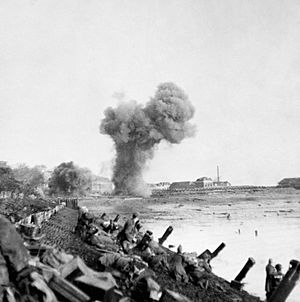
Opening the Port of Antwerp became very important for supplies. On September 12, the Canadian First Army was tasked with clearing the Scheldt river area. This involved four main steps.
First, they had to clear the area north of Antwerp. Second, they cleared the Breskens pocket. Third, they captured South Beveland. Finally, they took Walcheren Island.
The fighting was very tough. The Canadians faced strong German defenses and heavy counter-attacks. They suffered many casualties. But slowly, they pushed the Germans back.
The British and Polish forces also helped. They fought hard to clear the river banks. The island of Walcheren was a strong German fort. Its dikes were bombed to flood the island. This forced the Germans to higher ground. Allied troops then used special amphibious vehicles.
After much fighting, the Allies captured Walcheren. The Scheldt estuary was finally clear. On November 28, the first supply convoy entered the port of Antwerp. This was a huge help for the Allied armies.
Operations Veritable and Grenade
These operations aimed to clear the west bank of the Rhine river. The Canadian First Army would advance southeast. The U.S. Ninth Army would advance northeast. They planned to meet in the Geldern area.
These attacks were delayed by the Battle of the Bulge. When they finally started in February 1945, the Canadian attack (Operation Veritable) began first. The U.S. attack (Operation Grenade) was delayed because the Germans flooded the Roer river valley.
This delay allowed the Germans to focus their defenses on the Canadian forces. But they could only slow them down. When the Americans finally advanced, the Germans had few reserves left. The two armies met at Geldern. They pushed the Germans out of the area by March 21.
Central Allied Armies (12th Army Group)
Advance Through France and Belgium
The U.S. First Army moved quickly through northern France and Belgium. Their main goal was to reach the Rhine river. They wanted to get there before the Germans could set up strong defenses. During the Battle of the Mons Pocket, the Allies surrounded many Germans near Mons, Belgium. They took about 25,000 prisoners.
Battle for Aachen
The U.S. First Army focused on capturing Aachen. This city was important because it was the first German city to be attacked. Adolf Hitler ordered that Aachen be held at all costs. This forced the Allies to change their plans.
Some historians believe fighting for Aachen was a mistake. The battle slowed down the Allied advance. It also caused about 5,000 Allied casualties. The fighting was very tough, street by street. It used up many resources. Some think it would have been better to go around Aachen. This would have cut off the German defenders.
Lorraine Campaign
In late August, the U.S. Third Army ran low on fuel. This was because they had advanced so fast. Also, supplies were sent to the northern armies to help open Antwerp. By September 1, the Third Army almost stopped moving. This allowed the Germans to regroup and strengthen their defenses.
The Third Army then faced Metz. This was a very strong city, part of the Maginot Line. Metz could not be bypassed. Its forts had guns that controlled roads and river crossings. The Third Army fought a hard battle to capture Metz.
After Metz, the Third Army continued east. They reached the Saar River and began attacking the Siegfried Line.
Battle of Hürtgen Forest
The Hürtgen Forest was a dense, difficult area. It was seen as a place where Germans could attack the American side. Also, dams in the area could flood the Allied advance. So, an attack to clear the forest began in September 1944.
The Germans defended very stubbornly. The forest terrain helped them greatly. It made it hard for the Americans to use their larger numbers. The battle lasted until February 1945. It caused 33,000 American casualties. Many historians question if this battle was worth the losses.
Operation Queen
Operation Queen was a big attack by the U.S. Ninth and First Armies. It also involved Allied air forces. The main goal was to reach the Roer River. They wanted to cross it to push deeper into Germany. This operation included more fighting in the Hürtgen Forest.
The attack started in November with heavy air bombings. Even though the Germans had fewer soldiers, the Allied advance was very slow. After four weeks, the Allies reached the Roer. But they could not cross it. The fighting was exhausting. It caused many Allied casualties. Then, the Germans launched their own big counter-attack, the Battle of the Bulge.
Winter Counter-Offensives
Battle of the Bulge
The Germans had been planning a huge counter-attack since the Allies left Normandy. This plan was called Wacht am Rhein ("Watch on the Rhine"). They aimed to attack through the Ardennes forest. Then, they would turn north to Antwerp. This would split the American and British armies.
The attack began on December 16. It became known as the Battle of the Bulge. American troops in the Ardennes faced the attack. The Germans had early success due to bad weather. This weather hid them from Allied planes. But the Allies launched a counter-attack. They pushed the Germans back to where they started by January 25, 1945.
Operation Nordwind
The Germans launched a second, smaller attack on January 1, 1945. This was called Nordwind. They attacked in Alsace, trying to recapture Strasbourg. Allied lines were stretched thin because of the Battle of the Bulge. So, stopping Nordwind was very costly. It lasted almost four weeks. Allied counter-attacks pushed the Germans back to the border.
Germany West of the Rhine
The plan was for the Canadian First Army and the U.S. Ninth Army to meet. They would clear the west bank of the Rhine river. This was planned for February 8, 1945. But it was delayed for two weeks. The Germans flooded the Roer valley by destroying dams.
During this flood, Hitler ordered his troops not to retreat behind the Rhine. He wanted them to fight where they stood. By the time the water went down, the U.S. Ninth Army crossed the Roer on February 23. Other Allied forces were also close to the Rhine.
The German divisions on the west bank of the Rhine were badly beaten. About 280,000 German soldiers were captured. The Germans' stubborn defense was very costly. Their total losses were around 400,000 soldiers.
After the Campaign
The Allies crossed the Rhine river at four main points.
- The U.S. First Army captured the Ludendorff Bridge at Remagen on March 7. The Germans failed to blow it up. This allowed the Americans to quickly cross the Rhine.
- General George S. Patton's U.S. Third Army crossed the Rhine quickly on the night of March 22/23. They crossed south of Mainz at Oppenheim.
- In the north, the Rhine is much wider. Bernard Montgomery's 21st Army Group planned a careful attack. In Operation Plunder, they crossed the Rhine at Rees and Wesel on March 23/24. This included a huge airborne operation called Operation Varsity.
- The U.S. Seventh Army crossed the Rhine between Mannheim and Worms on March 26. The French First Army also made a smaller crossing later at Speyer.
After crossing the Rhine, the Allies moved very quickly into Germany. World War II in Europe ended soon after. Germany surrendered on May 7.
See also
- Liberation of France


